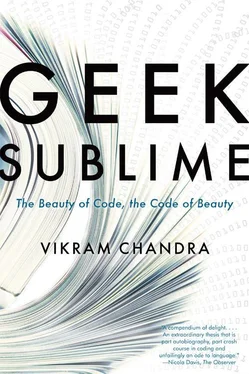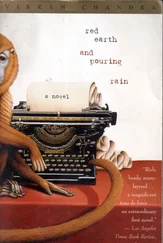We can see that the operations of suggestion are heavily dependent on context (as in “The sun has set”). Whereas the denotative and connotative meanings of a phrase or a text are limited, vyanjana is infinite and can never be exhausted. Consider the following verse, in which the speaker is Rama, the hero of the Ramayana ; the season is the monsoon, when lovers come together. Rama has lost his kingdom through court intrigue, has been banished to the wilderness, has faced many dangers, and his beloved wife has been kidnapped by the evil Ravana.
Clouds smear the sky,
flocks of cranes tremble
across their viscous blue-black beauty.
The winds sprinkle rain, the peacocks call
their soft cries of joy.
Let all this be, as it likes. I am Rāma.
I am hard-hearted, I can endure all.
But Vaidehī? How will she survive?
Ah alas, my goddess, be strong!
47
Anandavardhana writes, “In this verse, the [suggestive] word is ‘Rama.’ By this word we understand Rama as developed into various suggested qualities, not simply as the possessor of the name.” 48That is, the reader already knows that the speaker is Rama; no information is added here by the use of the name. But the name evokes, for the reader, all the tragedy and suffering that this man has already experienced and will experience in the future. In a flash, this sudden explosion of light illuminates the past and the future.
A century later, the greatest exponent of rasa-dhvani theory, Abhinavagupta, wrote about this verse:
The suggestions of other properties … are endless; for example, his banishment from the kingdom, etc. And since these suggestions are countless, they cannot be conveyed [simultaneously] by means of the denotative functions of words. Even if these innumerable suggested properties were to be conveyed [by denotation] one by one, since they will not be had in one single act of cognition, they will not be the source of a wondrous aesthetic experience and hence they will not give rise to a great beauty. But if these properties are suggested, they will assume countless forms ( kiṃkiṃ. rūpaṃ na sahate ) because in the suggestion their separateness will not be clearly perceived. In this way they will become the source of a strikingly beautiful aesthetic pleasure that is analogous to the flavor of a wonderful drink, or cake, or sweet confection [where the individual ingredients cannot be separately tasted but yet add to the flavor of the final product]. For it has been said already [by Anandavardhana] that a word which is suggestive reveals a beauty “which cannot be conveyed by another form of expression.” 49

Rasa-dhvani can operate at the level of a word, a sentence, or an entire work. According to Anandavardhana, rasa is “an object on which no words can operate directly,” and therefore dhvani is the only way to manifest rasa. 50 So Anandavardhana might have said to an aspiring writer: suggest, don’t tell. Dhvani is literally “reverberation,” and is often compared to the “sounding of a bell” or “a needle falling through a pile of lotus leaves.” If we hear the phrase, “A village on the Ganga” (in Sanskrit, gangayam ghoshah , literally “a village in the Ganga”) we understand that the village cannot literally rest on the water, and that we are talking about a village located on the banks of the Ganga. This would be an example of figurative speech. But Anandavardhana would argue that this phrase about the holy river also carries a suggestion — or causes in the listener the manifestation — of coolness, sanctity. This underlying, affective meaning does not emerge from the denotative or figurative aspects of the phrase. This kind of suggestion functions in all speech, is present even in mundane language, but poets knowingly and intentionally concentrate vyanjana to construct a coherent, sustained engagement within the reader, and thus to manifest dhvani , and hence rasa. Patrick Colm Hogan writes:
Rasadhvani , the “truest” form of dhvani , it is an experience — along the lines of what we would call “a moment of tenderness” or “a pang of sadness.” It is, in short, an experience of rasa … [These rasas] are evoked through the clouds of non-denumerable, non-substitutable, non-propositional suggestions which surround these texts. 51
The very sounds and rhythms of language — which preexist meaning — contribute to our experience of rasa. Abhinavagupta says that when we hear poetic language
without waiting for our understanding of the expressed meaning, [the stylistic qualities] set about building up the rasas , giving us a foretaste ( āsvāda ) of them. This is as much to say that as the rasas are suggested by style ( saṅghaṭanā ), the ground is laid for the relishing of a rasa at the very beginning of the appropriate style before our understanding of the meaning has come into play; and that it is on this account that the rasa , even at the later moment, after we have understood the expressed meaning and when the rasa has assumed its full flavour, does not appear to have arisen later [than our understanding]. 52

Anandavardhana observes, “When ornamented by even one from among the varieties of dhvani , speech acquires a fresh colour, even though it follows a subject matter that has been treated by poets of the past.” 53Since the properties manifested by dhvani are countless, “poetical material … finds no limit …”
Not even Vacaspati [the god of speech] in a thousand efforts could exhaust it, any more than he could exhaust the nature of the universe.
For just as the nature of the universe, although it has manifested this marvellous proliferation of matter through the succession of past ages, cannot be said now to be worn out and unable to create anything new, just so is the situation in poetry, which, although it has been worked over by the minds of countless poets, is not thereby weakened, but increases with ever new artistic abilities. 54
Anandavardhana accepted that there may be poetic texts in which the suggested meaning isn’t the dominant pleasure, or even present at all; he rather disdainfully refers to the latter as chitra kavya , picture poetry, flashy poetry: “Poetry which lacks rasa or an emotion ( bhāva ) as its final meaning, which is composed only by relying on novelties of literal sense and expression, and which gives the appearance of a picture, is citra …” Poetry that “gives the appearance of a picture” refers to very difficult pictorial arrangements in verse, similar to visual pattern poetry and topiary verses in the West — Sanskrit writers wrote stanzas in which interlocking syllables, if connected by drawn lines, revealed the shapes of drums, swords, wheels, and so on. 55This chitrabandha is probably where the more general term chitra kavya originates. Anandavardhana continues, “[This poetry also includes] verbal citra , such as difficult arrangements, yamakas (echo alliterations), and the like. Semantic citra … may be exemplified by poetic fancy ( utprekṣā ) and such figures … It is not real poetry, for it is an imitation of poetry.” 56
Now that Anandavardhana has shown us how vyanjana works in poetry to produce dhvani and rasa , he tells us, “Now that instruction is being offered to modern poets in the true principles of poetry, while citra may be much used in the efforts of beginners who are seeking practise, it is established for mature poets that dhvani alone is poetry.” 57
Читать дальше













